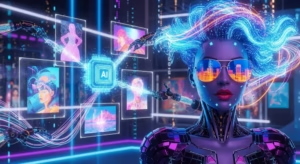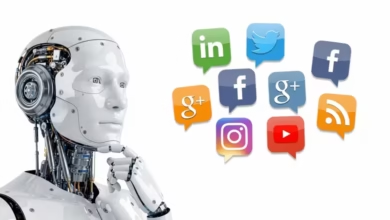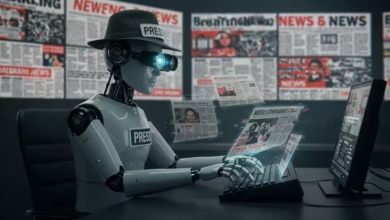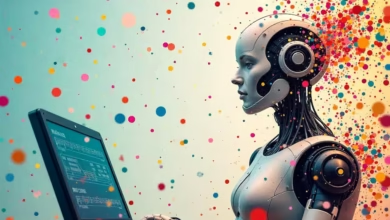AI and Digital Art: Redefining Creativity in the Age of Machines

In the blog post AI and Digital Art: Redefining Creativity in the Age of Machines, the author explores the transformative impact of AI in digital art. It begins by discussing the role of AI in digital art creation, highlighting innovative techniques that enable artists to expand their creative horizons. The post delves into the emergence of AI art generation, illustrating how machine learning algorithms can produce unique artworks. Additionally, it compares traditional art with NFTs, detailing the implications of digital ownership in the art world. Lastly, the author provides actionable insights for artists looking to harness the power of creative AI tools, ensuring they remain relevant in an evolving landscape. This article is a must-read for anyone interested in the intersection of technology and art, emphasizing the crucial role of AI in digital art today.
Understanding The Role Of AI In Digital Art

The emergence of AI in digital art has significantly transformed the creative landscape, allowing artists to explore new horizons and redefine their craft. As artists increasingly leverage creative AI tools, the fusion of technology and tradition opens up a dialogue about the nature of creativity itself. AI-generated works challenge long-held assumptions of artistic expression, prompting both excitement and apprehension within the artistic community. Artists are no longer limited to traditional methods; instead, they can harness the power of AI to amplify their creative voices and expand their narratives in unprecedented ways.
Key Aspects Of AI In Digital Art
- Augmentation of traditional artistic techniques
- Automation of repetitive processes in art creation
- Facilitation of personalized art experiences
- Enabling interactive installations and immersive environments
- Fostering collaboration between humans and machines
- Exploration of new aesthetics through machine learning
As we delve deeper into the world of creative AI tools, it becomes clear that these innovations do not replace the artist; rather, they enhance the artist’s ability to generate unique and complex artworks. The integration of AI in digital art allows for a broader interpretation of creativity that acknowledges both human intuition and algorithmic logic. By blending these elements, artists can push boundaries, leading to revolutionary techniques and concepts that will shape the future of the art world.
Exploring AI Art Generation And Its Techniques

The emergence of AI art generation has transformed the landscape of digital creativity, allowing artists and hobbyists alike to explore new realms of generative visuals. With advanced algorithms and machine learning techniques, AI systems can analyze and synthesize vast amounts of data, creating artwork that ranges from stunning to bizarre. As these tools evolve, they blur the lines between human creativity and machine-generated content, raising intriguing questions about authorship and originality in the digital art world.
Moreover, various techniques underpin the realm of AI art generation, including neural style transfer, deep learning, and generative adversarial networks (GANs). Each method presents unique capabilities and results, empowering users to create diverse styles of artwork. As artists delve into these techniques, they discover innovative ways to incorporate AI tools into their creative processes, gaining limitless inspiration from the vast digital palettes these systems offer.
| Technique | Description | Popular Tools |
|---|---|---|
| Neural Style Transfer | Transferring the artistic style of one image to another. | DeepArt, Prisma |
| Generative Adversarial Networks (GANs) | Create new images by pitting two neural networks against each other. | RunwayML, Artbreeder |
| Variational Autoencoders (VAEs) | Generating new images based on learned data distributions. | Google Colab, OpenAI DALL-E |
As digital artists experiment with various AI tools, they often wonder about the practical application of these technologies in their creative workflows. The rise of AI art generators presents unique advantages that can enhance the creative process. From accelerating the ideation phase to providing unparalleled refinement of designs, these tools serve to expand artistic horizons and facilitate new forms of expression.
Steps To Create AI Art
- Choose an AI art generation platform that fits your artistic needs.
- Familiarize yourself with the platform’s tools and functionalities.
- Gather and prepare your input images or data sets for analysis.
- Experiment with different styles and settings to generate art.
- Refine and enhance the generated visuals using additional software if needed.
- Evaluate the output and select the most appealing designs for presentation.
- Share your creations and collaborate with other artists to gain feedback.
Popular AI Art Platforms
Several platforms have emerged as frontrunners in the field of AI in digital art, each offering unique features to cater to artists’ diverse needs. Some of the most popular options include DeepArt, Artbreeder, and RunwayML. These tools not only provide user-friendly interfaces but also integrate powerful AI capabilities that simplify the art creation process. As more artists adopt these platforms, the potential for collaboration and creativity expands, pushing the boundaries of what is considered art in this digital era.
Comparing Traditional And NFT Art In The Digital Age

As we delve deeper into the integration of technology and creativity, it’s essential to examine the contrasts between traditional art and NFT art. The emergence of AI in digital art has profoundly reshaped how artists create and how audiences interact with their work. Traditional art, which encompasses physical paintings, sculptures, and drawings, has long been revered for its tactile presence and emotional depth. However, as digital technologies advance, artists are increasingly turning to NFTs, which allow them to tokenize their creations and explore new avenues of market engagement.
While both artistic expressions possess unique characteristics, the fundamental differences lie in their mediums and the experiences they offer. Traditional art is often seen as a deeply personal journey, reflecting the artist’s skill and emotional state. In contrast, NFT art leverages blockchain technology, providing a decentralized platform where artists can sell their works directly to collectors. This shift not only changes the way art is perceived but also democratizes the art market, making it accessible to a broader audience.
Comparison Between Traditional Art and NFT Art
| Aspect | Traditional Art | NFT Art |
|---|---|---|
| Medium | Physical (canvas, paper, etc.) | Digital (JPEG, GIF, etc.) |
| Ownership | Subject to physical possession | Blockchain authenticated ownership |
| Market Dynamics | Established galleries, auctions | Decentralized marketplaces |
| Sale Process | Intermediate agents | Direct sales from artist to collector |
The conversation about traditional versus NFT art extends beyond mere aesthetic appeal; it intertwines with the larger discourse on value and authenticity. As the landscape shifts, artists and collectors alike are left to navigate this new frontier, challenging the conventions of what constitutes art in the digital age.
Pros And Cons Of NFTs Over Traditional Art
- Direct sales models eliminate intermediaries, resulting in higher profits for artists.
- NFTs provide a safeguard for authenticity through blockchain technology.
- Digital art can achieve global exposure instantly through online platforms.
- The environmental concerns around NFTs are increasingly being addressed through sustainable practices.
- Traditional art can be physically limited and costly to transport and maintain.
- NFT market volatility can pose financial risks for new investors.
- Collectors of traditional art may miss the inherently digital characteristics of NFTs, such as interactivity and programmability.
The fusion of AI technologies with digital art showcases a new era of creativity, allowing artists to push the boundaries of their imagination. In embracing both traditional and NFT art forms, we can better appreciate the evolving landscape of artistic expression and the potential it holds for the future.
NFT Art Market Overview
The NFT art market has exploded in recent years, reflecting a broader trend towards digital ownership and collectibles. Artists are now able to reach collectors without geographical limitations, and the convenience of trading digital assets has significantly broadened the scope of who can be considered an art collector. As digital currencies and platforms become more mainstream, the barriers to entry for emerging artists shrink, allowing for a diverse array of voices in this digital renaissance.
Actionable Insights For Utilizing Creative AI Tools
Embracing creative AI tools in digital art not only enhances artistic expression but also unlocks new dimensions of creativity. Artists can leverage the capabilities of AI to streamline their workflows, experiment with unique styles, and generate ideas that might otherwise remain unexplored. By integrating AI into the creative process, digital artists can experience a transformative shift, enriching their work with innovative techniques and perspectives that reflect the dynamic interaction between human creativity and machine intelligence.
Tips For Leveraging Creative AI Tools
- Start with a clear vision: Understand your artistic goals and how AI can support them.
- Experiment with different tools: Explore various creative AI applications to find the one that suits your style.
- Collaborate with the AI: Treat it as a partner in the creative process to enhance your artistic voice.
- Learn the basics of machine learning: Familiarize yourself with the underlying principles of AI to make the most of its capabilities.
- Stay updated on trends: Follow industry developments to adapt your methods and remain relevant.
- Engage with the community: Share your experiences and learn from other artists using AI tools.
- Continuously refine your approach: Iteratively improve your skillset and creative techniques with feedback.
Incorporating AI in digital art will undoubtedly challenge traditional boundaries of creativity. By strategically utilizing creative AI tools, artists can not only enhance their capabilities but also redefine the very nature of what art can be. The synergy between human imagination and artificial intelligence paves the way for a new era of artistic innovation, making it imperative for artists to embrace these tools and explore their transformative potential.
Briefing Document: AI and Digital Art – Redefining Creativity
This briefing document summarizes key themes and insights from the provided source on the transformative impact of Artificial Intelligence (AI) in digital art. The source highlights how AI is reshaping artistic creation, challenging traditional notions of creativity and ownership, and opening new avenues for artists through tools like AI art generation and NFTs. It emphasizes that AI tools augment rather than replace human artists, fostering collaboration between humans and machines.
Main Themes and Key Ideas:
1. The Transformative Role of AI in Digital Art:
- AI is fundamentally changing the creative landscape, allowing artists to “explore new horizons and redefine their craft.”
- The integration of AI “opens up a dialogue about the nature of creativity itself,” challenging “long-held assumptions of artistic expression.”
- AI empowers artists to “amplify their creative voices and expand their narratives in unprecedented ways,” moving beyond traditional methods.
2. Key Aspects of AI’s Influence on Digital Art:
- Augmentation and Automation: AI “augment[s] traditional artistic techniques” and “automate[s] repetitive processes in art creation.”
- Personalization and Immersion: It facilitates “personalized art experiences” and enables “interactive installations and immersive environments.”
- Collaboration and New Aesthetics: AI fosters “collaboration between humans and machines” and allows for the “exploration of new aesthetics through machine learning.”
- Enhancement, Not Replacement: The source explicitly states that “these innovations do not replace the artist; rather, they enhance the artist’s ability to generate unique and complex artworks.” It promotes a “broader interpretation of creativity that acknowledges both human intuition and algorithmic logic.”
3. The Emergence and Techniques of AI Art Generation:
- AI art generation leverages “advanced algorithms and machine learning techniques” to “create artwork that ranges from stunning to bizarre,” blurring the lines between human and machine creativity.
- Core Techniques:Neural Style Transfer: “Transferring the artistic style of one image to another.” (e.g., DeepArt, Prisma)
- Generative Adversarial Networks (GANs): “Create new images by pitting two neural networks against each other.” (e.g., RunwayML, Artbreeder)
- Variational Autoencoders (VAEs): “Generating new images based on learned data distributions.” (e.g., Google Colab, OpenAI DALL-E)
- Practical Application: AI art generators can “accelerate the ideation phase” and provide “unparalleled refinement of designs,” expanding artistic horizons.
- Workflow for AI Art Creation: The source outlines a seven-step process, from choosing a platform and familiarizing oneself with tools to preparing input, experimenting with settings, refining output, and sharing creations.
4. Comparing Traditional Art and NFT Art in the Digital Age:
- Medium and Ownership: Traditional art is “physical” with ownership subject to “physical possession,” while NFT art is “digital” with “blockchain authenticated ownership.”
- Market Dynamics: Traditional art operates through “established galleries, auctions,” whereas NFT art utilizes “decentralized marketplaces” and allows for “direct sales from artist to collector.”
- Democratization: NFTs “democratizes the art market, making it accessible to a broader audience.”
- Pros of NFTs:“Direct sales models eliminate intermediaries, resulting in higher profits for artists.”
- “NFTs provide a safeguard for authenticity through blockchain technology.”
- “Digital art can achieve global exposure instantly through online platforms.”
- Addressing environmental concerns through “sustainable practices.”
- Cons of NFTs:“NFT market volatility can pose financial risks for new investors.”
- “Collectors of traditional art may miss the inherently digital characteristics of NFTs, such as interactivity and programmability.”
- NFT Market Growth: The NFT art market has “exploded in recent years,” reflecting a shift towards digital ownership and allowing artists to “reach collectors without geographical limitations.”
5. Actionable Insights for Artists Utilizing Creative AI Tools:
- Enhance Artistic Expression: AI tools “enhance artistic expression but also unlock new dimensions of creativity.”
- Streamline and Experiment: Artists can “streamline their workflows, experiment with unique styles, and generate ideas.”
- Tips for Leveraging AI Tools:Start with a clear vision.
- Experiment with different tools.
- Collaborate with the AI (treating it as a partner).
- Learn the basics of machine learning.
- Stay updated on trends.
- Engage with the community.
- Continuously refine your approach.
- Redefining Art: The strategic use of “creative AI tools” will “challenge traditional boundaries of creativity” and “redefine the very nature of what art can be.” The “synergy between human imagination and artificial intelligence paves the way for a new era of artistic innovation.”
The source paints a comprehensive picture of AI’s profound impact on the art world, presenting it as a powerful augmentative force for human creativity rather than a replacement. It highlights the practical applications of AI art generation, the evolving landscape of digital ownership through NFTs, and provides concrete steps for artists to integrate these technologies into their practice. The overarching message is that embracing AI is crucial for artists to remain relevant and push the boundaries of artistic expression in this new, technologically-driven era.
Artificial intelligence / AI in Art, Creativity & Media
🎧 Listen to the Podcast
Want to explore this topic in more depth? Listen to the full podcast for more insights and expert commentary.
▶️ Play on Google DriveNo sign-up needed — just click and listen.
What are some key techniques used in AI art generation?
Several advanced techniques underpin AI art generation, allowing for diverse styles and results. These include:
- Neural Style Transfer: Transfers the artistic style of one image to another (e.g., DeepArt, Prisma).
- Generative Adversarial Networks (GANs): Create new images by pitting two neural networks against each other (e.g., RunwayML, Artbreeder).
- Variational Autoencoders (VAEs): Generate new images based on learned data distributions (e.g., Google Colab, OpenAI DALL-E). These methods empower artists to incorporate AI tools into their creative processes, offering limitless inspiration.
What are the practical steps to create AI art?
To create AI art, artists typically follow these steps:
- Choose a platform: Select an AI art generation platform that suits your artistic needs.
- Familiarize yourself: Learn the platform’s tools and functionalities.
- Prepare input: Gather and prepare input images or datasets for analysis.
- Experiment: Try different styles and settings to generate art.
- Refine: Enhance the generated visuals using additional software if necessary.
- Evaluate: Select the most appealing designs for presentation.
- Share and collaborate: Share your creations and engage with other artists for feedback.
How do traditional art and NFT art compare in the digital age?
Traditional art involves physical mediums and is valued for its tactile presence and emotional depth, with ownership tied to physical possession. Its market relies on established galleries and auctions, often involving intermediate agents.
NFT (Non-Fungible Token) art, conversely, is digital (e.g., JPEG, GIF) with ownership authenticated by blockchain technology. It thrives on decentralized marketplaces, allowing direct sales from artist to collector. While traditional art offers a personal journey, NFT art leverages technology for broader accessibility and market reach.
What are the advantages and disadvantages of NFTs compared to traditional art?
Pros of NFTs:
- Direct sales: Eliminate intermediaries, leading to higher profits for artists.
- Authenticity: Safeguarded through blockchain technology.
- Global exposure: Instant reach through online platforms.
- Addressing environmental concerns: Increasing focus on sustainable practices.
Cons of NFTs:
- Market volatility: Can pose financial risks for investors.
- Lack of physical presence: Collectors of traditional art might miss the tactile nature.
- Inherently digital characteristics: Features like interactivity and programmability might not appeal to all traditional art collectors.
What actionable insights can artists use to leverage creative AI tools effectively?
Artists can effectively leverage creative AI tools by:
- Clear vision: Understanding artistic goals and how AI can support them.
- Experimentation: Exploring various AI applications to find suitable styles.
- Collaboration: Treating AI as a partner in the creative process.
- Learning basics: Familiarizing oneself with underlying AI principles.
- Staying updated: Following industry trends to adapt methods.
- Community engagement: Sharing experiences and learning from others.
- Continuous refinement: Iteratively improving skills and techniques with feedback.
How does AI impact the definition of creativity itself?
AI's integration into digital art challenges long-held assumptions about artistic expression. It prompts a dialogue about the nature of creativity by demonstrating that unique and complex artworks can result from blending human intuition with algorithmic logic. AI tools don't replace the artist but rather amplify their creative voices, pushing boundaries and leading to revolutionary techniques that reshape the future of the art world. This expands the interpretation of creativity to include both human and machine contributions.
What is the overall impact of AI on the art market?
The emergence of AI, particularly in conjunction with NFTs, is democratizing the art market. NFT art, driven by blockchain technology, allows artists to sell their works directly to collectors without geographical limitations. This convenience of trading digital assets significantly broadens the scope of who can be considered an art collector, leading to a more diverse array of voices and lower barriers to entry for emerging artists in this digital renaissance.




